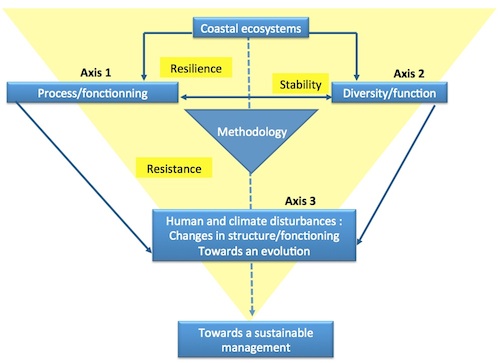Scientific objectives
Coastal and littoral zones, because of their productivity and the numerous ecosystem services they provide, of their human population density and the diversity of activities, produce strong societal challenges and are subjected to multiple pressures. Therefore, these zones need to be studied in order to understand the complexity of their functioning (for example through a trophic ecology approach), to characterize their biodiversity and its role from the community to ecosystem scales, and to quantify the effect of environmental changes on ecosystem functioning.
Our investigations, beyond answering fundamental questions, also address questions applied to societal problems. In particular, we aim to find efficient ways to characterize environmental quality in relation with economic activity (such as habitat and species protection, maintenance of functional biodiversity, rehabilitation of zones of biological interests, prediction of global change and anthropic impacts). Thus, the BIOFEEL team aims to acquire new knowledge about the functioning of ecosystems, and tries to develop decision support tools for a “sustainable and concerted” management of the resources. The team uses various approaches such as laboratory and field experiments, multivariate analysis and modeling.
The BIOFEEL team possesses the necessary skills and methodologies to study a large number of biological compartments, from pelagic and benthic zones (for example virus, microorganisms, meiofauna, macrofauna, fishes) to coastal avifauna (shorebirds) with an ecosystemic vision. We study the interactions between organisms (especially microorganisms) as well as the trophic relations between biological compartments. We specifically have a strong expertise in the study and the functioning of intertidal bare mudflats of western European coasts.




